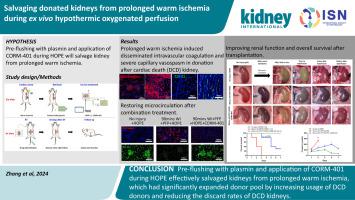当前位置:
X-MOL 学术
›
Kidney Int.
›
论文详情
Our official English website, www.x-mol.net, welcomes your feedback! (Note: you will need to create a separate account there.)
Salvaging donated kidneys from prolonged warm ischemia during ex vivo hypothermic oxygenated perfusion
Kidney International ( IF 14.8 ) Pub Date : 2024-05-22 , DOI: 10.1016/j.kint.2024.04.018 Peng Zhang , Chao Sun , Shuyong Mo , Chaoyu Hu , Yuxiang Ning , Han Liang , Zhongzhong Liu , Xiaoli Fan , Yanfeng Wang
Kidney International ( IF 14.8 ) Pub Date : 2024-05-22 , DOI: 10.1016/j.kint.2024.04.018 Peng Zhang , Chao Sun , Shuyong Mo , Chaoyu Hu , Yuxiang Ning , Han Liang , Zhongzhong Liu , Xiaoli Fan , Yanfeng Wang

|
Prolonged warm ischemic is the main cause discarding donated organs after cardiac death. Here, we identified that prolonged warm ischemic time induced disseminated intravascular coagulation and severe capillary vasospasm after cardiac death of rat kidneys. Additionally, we found a significant accumulation of fibrinogen in a hypoxic cell culture of human umbilical vein epithelial cells and in isolated kidneys exposed to prolonged warm ischemic following flushing out of blood. However, pre-flushing the kidney with snake venom plasmin in a 90-minute warm ischemic model maximized removal of micro thrombi and facilitated the delivery of oxygen and therapeutic agents. Application of carbon monoxide–releasing CORM-401 during hypothermic oxygenated perfusion achieved multipath protective effects in prolonged warm ischemic kidneys. This led to significant improvements in perfusion parameters, restoration of the microcirculation, amelioration of mitochondrial injury, oxidative stress, and apoptosis. This benefit resulted in significantly prolonged warm ischemic kidney recipient survival rates of 70%, compared with none in those receiving hypothermic oxygenated perfusion alone. Significantly, hypothermic oxygenated perfusion combined with cytoprotective carbon monoxide releasing CORM-401 treatment meaningfully protected the donated kidney after cardiac death from ischemia-reperfusion injury by reducing inflammation, oxidative stress, apoptosis, and pathological damage. Thus, our study suggests a new combination treatment strategy to potentially expand the donor pool by increasing use of organs after cardiac death and salvaging prolonged warm ischemic kidneys.
中文翻译:

在离体低温氧合灌注期间从长期热缺血中挽救捐赠的肾脏
长时间的热缺血是心源性死亡后丢弃捐献器官的主要原因。在这里,我们发现,大鼠肾脏心源性死亡后,长时间的热缺血时间会诱导弥散性血管内凝血和严重的毛细血管痉挛。此外,我们发现在人脐静脉上皮细胞的缺氧细胞培养物中以及在血液冲出后暴露于长时间热缺血的离体肾脏中,纤维蛋白原显着积累。然而,在 90 分钟的热缺血模型中用蛇毒纤溶酶预冲洗肾脏可以最大限度地清除微血栓,并促进氧气和治疗药物的输送。在低温氧合灌注过程中应用释放一氧化碳的 CORM-401 对长期热缺血的肾脏实现了多路径保护作用。这导致灌注参数显着改善、微循环恢复、线粒体损伤、氧化应激和细胞凋亡的改善。与仅接受低温氧合灌注的患者相比,这一益处使热缺血肾受体的存活率显着延长至 70%。值得注意的是,低温氧合灌注联合释放一氧化碳的细胞保护性 CORM-401 治疗通过减少炎症、氧化应激、细胞凋亡和病理损伤,有意义地保护心脏死亡后的捐献肾脏免受缺血再灌注损伤。因此,我们的研究提出了一种新的联合治疗策略,通过增加心源性死亡后器官的使用和挽救长期温暖缺血的肾脏来潜在地扩大供体库。
更新日期:2024-05-22
中文翻译:

在离体低温氧合灌注期间从长期热缺血中挽救捐赠的肾脏
长时间的热缺血是心源性死亡后丢弃捐献器官的主要原因。在这里,我们发现,大鼠肾脏心源性死亡后,长时间的热缺血时间会诱导弥散性血管内凝血和严重的毛细血管痉挛。此外,我们发现在人脐静脉上皮细胞的缺氧细胞培养物中以及在血液冲出后暴露于长时间热缺血的离体肾脏中,纤维蛋白原显着积累。然而,在 90 分钟的热缺血模型中用蛇毒纤溶酶预冲洗肾脏可以最大限度地清除微血栓,并促进氧气和治疗药物的输送。在低温氧合灌注过程中应用释放一氧化碳的 CORM-401 对长期热缺血的肾脏实现了多路径保护作用。这导致灌注参数显着改善、微循环恢复、线粒体损伤、氧化应激和细胞凋亡的改善。与仅接受低温氧合灌注的患者相比,这一益处使热缺血肾受体的存活率显着延长至 70%。值得注意的是,低温氧合灌注联合释放一氧化碳的细胞保护性 CORM-401 治疗通过减少炎症、氧化应激、细胞凋亡和病理损伤,有意义地保护心脏死亡后的捐献肾脏免受缺血再灌注损伤。因此,我们的研究提出了一种新的联合治疗策略,通过增加心源性死亡后器官的使用和挽救长期温暖缺血的肾脏来潜在地扩大供体库。











































 京公网安备 11010802027423号
京公网安备 11010802027423号